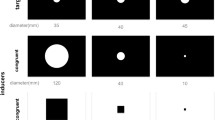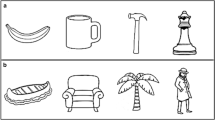Abstract
Anatomical and physiological evidence suggests that vision-for-perception and vision-for-action may be differently sensitive to increasingly peripheral stimuli, and to stimuli in the upper and lower visual fields (VF). We asked participants to fixate one of 24 randomly presented LED arranged radially in eight directions and at three eccentricities around a central target location. One of two (small, large) target objects was presented briefly, and participants responded in two ways. For the action task, they reached for and grasped the target. For the perception task, they estimated target height by adjusting thumb-finger separation. In a final set of trials for each task, participants knew that target size would remain constant. We found that peak aperture increased with eccentricity for grasping, but not for perceptual estimations of size. In addition, peak grip aperture, but not size-estimation aperture, was more variable when targets were viewed in the upper as opposed to the lower VF. A second experiment demonstrated that prior knowledge about object size significantly reduced the variability of perceptual estimates, but had no effect on the variability of grip aperture. Overall, these results support the claim that peripheral VF stimuli are processed differently for perception and action. Moreover, they support the idea that the lower VF is specialized for the control of manual prehension. Finally, the effect of prior knowledge about target size on performance substantiates claims that perception is more tightly linked to memory systems than action.






Similar content being viewed by others
References
Amazeen E, DaSilva F (2005) Psychophysical test for the independence of perception and action. J Exp Psychol Hum Percept Perform (in press)
Averbach E, Sperling G (1960) Short term storage of information in vision. In: Cherry C (ed) Information theory. Butterworth, London, pp 243–255
Azzopardi P, Jones KE, Cowey A (1999) Uneven mapping of magnocellular and parvocellular projections from the lateral geniculate nucleus to the striate cortex in the macaque monkey. Vis Res 39:2179–2189
Bedell HE, Johnson CA (1984) The perceived size of targets in the peripheral and central visual fields. Ophthal Physiol Opt 4(2):123–131
Bock O (1986) Contributions of retinal versus extraretinal signals toward visual localization in goal-directed movements. Exp Brain Res 64:476–482
Brown LE, Moore CM, Rosenbaum DA (2002) Feature-specific processing dissociates action from recognition. J Exp Psychol Hum Percept Perform 28:1330–1344
Colby CL, Gattass R, Olson CR, Gross CG (1988) Topographical organization of cortical afferents to extrastriate visual area PO in the macaque: a dual tracer study. J Comp Neurol 269:392–413
Collier RM (1931) An experimental study of form perception in peripheral vision. J Comp Neurol 1:281–289
Connolly M, Van Essen DC (1984) The representation of the visual field in parvocellular and magnocellular layers of the lateral geniculate nucleus in the macaque monkey. J Comp Neurol 226:544–564
Corballis PM (2003) Visuospatial processing and the right-hemisphere interpreter. Brain Cogn 53:171–176
Corballis PM, Funnell MG, Gazzaniga MS (2002) Hemispheric asymmetries for simple visual judgments in the split brain. Neuropsychologia 40:401–410
Culham JC, Danckert SL, DeSouza JFX, Gati JS, Menon RS, Goodale MA (2003) Visually guided grasping produces fMRI activation in dorsal but not ventral stream brain areas. Exp Brain Res 153:180–189
Curcio CA, Allen KA (1990) Topography of ganglion cells in human retina. J Comp Neurol 300:5–25
Danckert J, Goodale MA (2001) Superior performance for visually guided pointing in the lower visual field. Exp Brain Res 137:303–308
Danckert J, Goodale MA (2003) The ups and downs of visual perception. In: Johnson SH (ed) Cognitive neuroscience perspectives on the problem of intentional action. MIT Press, Cambridge, MA, pp 29–64
Favilla M, Hening W, Ghez C (1989) Trajectory control in targeted force impulses. VI. Independent specification of response amplitude and direction. Exp Brain Res 75:280–294
Fitts PM (1954) The information capacity of the human motor system in controlling the amplitude of movement. J Exp Psychol 47:151–157
Funnell MG, Corballis PM, Gazzaniga MS (1999) A deficit in perceptual matching in the left hemisphere of a callosotomy patient. Neuropsychologia 37:1143–1154
Galletti C, Fattori P, Kutz DF, Gamberini M (1999) Brain location and visual topography of cortical area V6A in the macaque monkey. Exp Brain Res 124:287–294
Goodale MA, Milner AD (1992) Separate visual pathways for perception and action. TINS 15:20–25
Goodale MA, Murphy KJ (1997) Perception and action in the visual periphery. In: Their P, Karnath HO (eds) Parietal lobe contributions to orientation in 3D space. Springer-Verlag, Heidelberg, pp 447–461
Goodale MA, Milner AD, Jakobson LS, Carey DP (1991) A neurological dissociation between perceiving objects and grasping them. Nature 349:154–156
Haffenden AG, Goodale MA (1998) The effect of pictorial illusion on prehension and perception. J Cogn Neurosci 10:122–136
Haffenden AG, Goodale MA (2000) Independent effects of pictorial displays on perception and action. Vis Res 40:1597–1607
Henriques DYP, Crawford JD (2000) Direction-dependent distortions of retinocentric space in the visuomotor transformation for pointing. Exp Brain Res 132:179–194
Henriques DYP, Crawford JD (2001) Role of eye, head, and shoulder geometry in the planning of accurate arm movements. J Neurophysiol 87:1677–1685
Henriques DYP, Klier EM, Smith MS, Lowy D, Crawford JD (1998) Gaze-centered remapping of remembered visual space in an open-loop pointing task. J Neurosci 18:1583–1594
Jakobson LS, Goodale MA (1991) Factors affecting higher-order movement planning: a kinematic analysis of human prehension. Exp Brain Res 86:199–208
Malpeli JG, Lee D, Baker FH (1996) Laminar and retinotopic organization of the macaque lateral geniculate nucleus: magnocellular and parvocellular magnification functions. J Comp Neurol 375:363–377
Maunsell JHR, Van Essen DC (1987) Topographical organization of the middle temporal visual area in the macaque monkey: representation biases and the relationship to callosal connections and myeloarchitectonic boundaries. J Comp Neurol 266:535–555
Meulenbroek RGJ, Rosenbaum DA, Jansen C, Vaughan J, Vogt S (2001) Multijoint grasping movements: simulated and observed effects of object location, object size, and initial aperture. Exp Brain Res 138:219–234
Milner AD, Goodale MA (1995) The visual brain in action. Oxford University Press, Oxford
Newsome LR (1972) Visual angle and apparent size of objects in peripheral vision. Percept Psychophys 12:300–304
Palmer S (1999) Vision science. MIT Press, Cambridge, MA
Paulignan Y, MacKenzie C, Marteniuk R, Jeannerod M (1991) Selective perturbation of visual input during prehension movements: I. The effect of changing object position. Exp Brain Res 83:502–512
Perenin MT, Vighetto A (1988) Optic ataxia: a specific disruption in visuomotor mechanisms. I. Different aspects of the deficit in reaching for objects. Brain 111:643–674
Previc FH (1990) Functional specialization in the lower and upper visual-fields in humans—its ecological origins and neurophysiological implications. Behav Brain Sci 13:519–541
Roy AC, Paulignan Y, Meunier M, Boussaoud D (2002) Prehension movements in the macaque monkey: effects of object size and location. J Neurophys 88:1491–1499
Schlicht EJ, Schrater PR (2003) Bayesian model for reaching and grasping peripheral and occluded targets. J Vis 3:261a
Schneider B, Ehrlich DJ, Stein R, Falum M, Mangel S (1978) Changes in the apparent lengths of lines as a function of degree of retinal eccentricity. Perception 7:215–223
Van Doorn AJ, Koenderink JJ, Bouman MA (1972) The influence of retinal inhomogeneity on the perception of spatial patterns. Kybernetik 10:223–230
Van Essen DC, DeYoe EA (1995) Concurrent processing in the primate visual cortex. In: Gazzaniga MS (ed) The cognitive neurosciences. MIT Press, Cambridge, MA, pp 383–400
Van Essen DC, Newsome WT, Maunsell JHR (1984) The visual field representation in striate cortex of the macaque monkey: asymmetries, anisotropies and individual variability. Vis Res 24:429–448
Wassle H, Grunert U, Rohrenbeck J, Boycott BB (1990) Retinal ganglion cell density and cortical magnification factor in the primate. Vis Res 11:1897–1911
Westwood DA, Goodale MA (2003) Perceptual illusion and the real-time control of action. Spat Vis 16:243–254
Acknowledgments
Portions of this research were presented at the 2004 meeting of the Canadian Society for Brain, Behaviour, and Cognitive Science, St. John’s, Newfoundland. We wish to thank Dan Pulham and Haitao Yang for construction of the equipment and computer programming necessary to run the experiment. This project was supported by an NSERC (Canada) grant to MAG.
Author information
Authors and Affiliations
Corresponding author
Rights and permissions
About this article
Cite this article
Brown, L.E., Halpert, B.A. & Goodale, M.A. Peripheral vision for perception and action. Exp Brain Res 165, 97–106 (2005). https://doi.org/10.1007/s00221-005-2285-y
Received:
Accepted:
Published:
Issue Date:
DOI: https://doi.org/10.1007/s00221-005-2285-y




